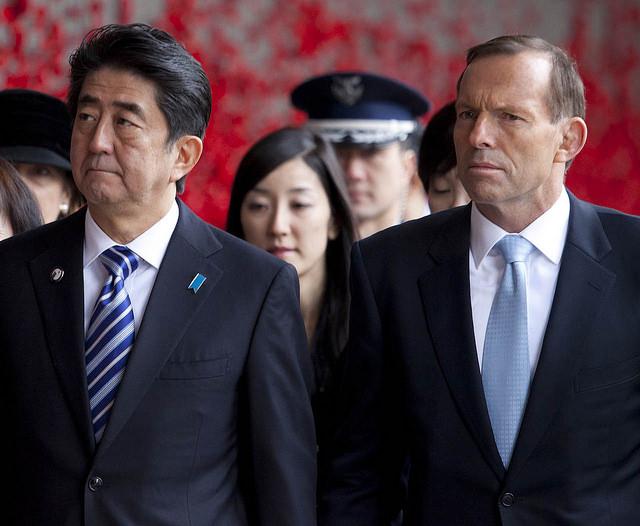Australia, Japan and the future of strategic relationships in Asia
Posted By Rod Lyon on July 10, 2014 @ 06:00
The rapidly-warming strategic relationship between Australia and Japan has drawn considerable attention this week. Some are for it, some are against it. Some see it as a mechanism to reinforce the growth of a responsible Japanese strategic role [2] in the Indo-Pacific. Others see it as likely to entangle Australia [3] in an emerging zero-sum strategic contest between China and Japan. And still others believe it’ll enable us—finally—to solve the issue of Australia’s future submarine [4].
I tend to favour the first of those views, but want to explore a different side of the relationship here: what does the emerging ‘special relationship’ between Canberra and Tokyo tell us about future strategic relationships in Asia? Since the early days of the Cold War, the Asian security architecture has been characterised by three core elements: a set of US alliances; a range of countries pursuing national, self-reliant defence policies; and (since the late 1960s) a set of multilateral security dialogues. Actual, close, bilateral or trilateral defence cooperation between Asian countries has been rare. Yes, the Five Power Defence Arrangements (FPDA) have provided a framework for Malaysia and Singapore to interact, but FPDA tends to be an exception that underlines the more general rule.
As Asian transformation unfolded (and continues to unfold), it was always an open question what effect it would have on that architecture. Obviously, rapid economic growth and industrialisation would enhance national defence force capabilities. But would more alliance ‘spokes’ gradually be added to the hub-and-spokes model? Or would there be fewer spokes as US allies gravitated towards actual self-reliance and Washington quietly encouraged greater intra-Asian cooperation? Would the multilateral structures become more influential in shaping the regional order, or less so? And would particular Asian countries form closer bonds with each other and, if so, what might be the nature of those bonds? In short, Asian transformation did more than raise uncertainties over which countries might be the positive security contributors of the 21st century; it raised uncertainties about the shape of future regional strategic relationships.
For a long time, one of those questions—the one about Asian bonding—tended to receive only a glib answer: we would see the growth of ‘strategic partnerships’ in Asia, complementing the other elements of the earlier structure. In reality, though, such partnerships have been difficult to form. True, both Tony Abbott and Shinzo Abe have used the vocabulary of strategic partnership when speaking about their new bond. But they’ve also used a more exclusive term—a ‘special relationship’. In the international arena, that terminology is comparatively unusual. It’s a term that’s certainly been used in relation to the US–UK relationship, and sometimes in relation to the US-Germany relationship. It’s a phrase that bespeaks an unusual closeness.
My impression is that the term’s similarly rare in the Australian strategic lexicon and, again—when used in its genuine strategic context, and not merely as diplomatic flattery—tends to be reserved for allies. Some academics have used the term to describe the US–Australia tie (‘the other special relationship [5]’). But, on the whole, Australian strategic policymakers haven’t spoken much about ‘special relationships’ between Australia and Asian countries. That we’ve done so in this case actually suggests a much deeper form of strategic connection between Japan and Australia than some might have imagined.
That connection has been driven by leaders: Abe and Abbott have made the connection happen, overriding the hesitancy of some in their ranks. Abbott gives every sign of being someone who’s not afraid to bite the bullet on Australian strategic relationships in Asia. His early success in strengthening the Australia–Japan relationship might be a harbinger of a more energetic Australian strategic policy towards Asia as a whole, not just towards Tokyo. Given Australian policy towards Asia has been primarily transactional, signs of deeper-level engagement are probably overdue. Meanwhile, Abe has wrought a quiet revolution in Japanese strategic policy, and shows no sign of slowing the momentum of reform running through Tokyo. But if the connection really is going to allow cooperation on something as sensitive as submarine drive trains, or even whole submarines, the degree of Japanese buy-in to the special relationship is indeed extraordinary.
Does that mean we could see other special relationships emerge in Asia as other national leaders grasp the nettle? I suspect not. The unfolding Australia–Japan relationship looks likely to be atypical of what emerges. It’s likely to set a benchmark in strategic cooperation that few other such relationships could achieve. But it does suggest that important levels of strategic cooperation among a select group of Asian states are going to be a part of the new regional architecture. And the government has done well to reach both that conclusion, and the resulting agreement, so adroitly.
Rod Lyon is a fellow at ASPI and executive editor of The Strategist. Image courtesy of Flickr user Australian War Memorial [6].
Article printed from The Strategist: https://aspistrategist.ru
URL to article: /australia-japan-and-the-future-of-strategic-relationships-in-asia/
URLs in this post:
[1] Image: https://aspistrategist.ru/wp-content/uploads/2014/07/14416266988_0dd4337d2b_z.jpg
[2] a responsible Japanese strategic role: https://www.aspistrategist.ru/publications/opinion-pieces/strong-links-with-asia-should-drive-defence-ties
[3] entangle Australia: http://www.theage.com.au/comment/abbott-should-think-twice-before-becoming-friendly-with-japan-20140707-zsynj.html
[4] Australia’s future submarine: http://www.theaustralian.com.au/national-affairs/policy/japan-to-help-with-stealth-subs/story-e6frg8yo-1226952498528?nk=e1a03b327f062a93bf5ae5e0119684d8
[5] the other special relationship: http://www.strategicstudiesinstitute.army.mil/pdffiles/pub760.pdf
[6] Australian War Memorial: https://www.flickr.com/photos/australianwarmemorial/14416266988/in/photolist-nXV8Vo-nXVfuX-odnzdj-ofmqUS-nXW7MP-ofeoi5-nXW7EK-ofpvyt-ohbnAX-nXUWwU-ofeomS-ofeosy-odnyXj-nXVfKg-ofeo8f-nXVfoe-odnz9S-of7LQv-odnyUU-ofeokQ-odnyVL-ofeo8L-nXUWAb-nXUWrU-ofeok9-odnz2C-ofpvx6
Click here to print.
